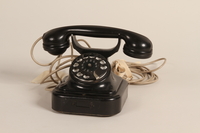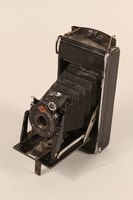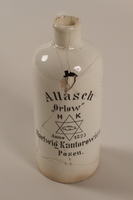Overview
- Brief Narrative
- Ten kilo (22 pound) spring balance scale with weighing pan likely produced in Germany around the turn of the 20th century. Scales such as this would be used at small farms or shops to weigh vegetables or other solid materials.
- Date
-
manufacture:
approximately 1900
- Credit Line
- United States Holocaust Memorial Museum Collection
- Markings
- a. front, dial, top center, black paint : Wirtschafts Wa(age?) [Economic Balance]
a. front, dial, top left, black paint : KILO / pound symbol
a. front, dial, bottom center, black paint : 10 KILO
a. top, center, engraved : P.P B6
a. back, right, engraved : B1
Physical Details
- Language
- German
- Classification
-
Tools and Equipment
- Category
-
Measuring instruments
- Object Type
-
Spring balances (aat)
- Physical Description
- a. Silver colored cast metal spring balance scale with a flat, vertical body, a curved upper half, a straight base and lower sides, and 2 rectangular pedestal feet. On the front, set into a raised rim, is a large, flat, white enameled metal dial with an outer ring of painted black lines and numbers. The numbers indicate weights: 0 – 20 pounds along the inner ring and 0 – 10 kilos with fractional increments along the outer. Below, the body is embossed with a row of 3 diamonds flanked by short zig-zags. On the back center, a rectangular metal housing for the inner works is mounted between 2 parallel vertical ridges. It has an open base, a ridged back, and the top is covered by a horizontal panel extending from the body. On top, a threaded metal post with a circular head is fixed to the right of a hole from which a vertical rod extends. Screwed to the top is a horizontal metal ring with central cross bars and 4 upward curving, flared prongs to support a weighing pan.
b. Large, shallow, oval silver colored metal weighing pan for a spring scale. It has a flat, slightly raised base, rounded, gently sloped sides, and a rolled rim. The surface is discolored, worn, and slightly dented.
c. Thin, flat, corroded silver colored metal indicator needle with a tapered point from the dial of a spring scale (a). The point extends from a central disk, which has a domed, brass colored metal mount. Extending from the disk, opposite the point, is an oval with a ring at the end.
d. Sixteen different sized, irregularly shaped flakes of enamel paint from the white dial of a spring scale (a). Several of the flakes are painted with black markings from the product label or the number line. - Dimensions
- a: Height: 8.375 inches (21.273 cm) | Width: 7.125 inches (18.097 cm) | Depth: 4.375 inches (11.113 cm)
b: Height: 0.250 inches (0.635 cm) | Width: 10.125 inches (25.718 cm) | Depth: 7.250 inches (18.415 cm)
c: Height: 3.375 inches (8.573 cm) | Width: 0.500 inches (1.27 cm) | Depth: 0.250 inches (0.635 cm)
d: Height: 1.000 inches (2.54 cm) | Width: 0.625 inches (1.588 cm) - Materials
- a : metal, enamel paint, paint
b : metal
c : metal
d : enamel paint, paint
Rights & Restrictions
- Conditions on Access
- No restrictions on access
- Conditions on Use
- No restrictions on use
Keywords & Subjects
Administrative Notes
- Legal Status
- Permanent Collection
- Provenance
- The scale was acquired by the United States Holocaust Memorial Museum in 1990.
- Funding Note
- The cataloging of this artifact has been supported by a grant from the Conference on Jewish Material Claims Against Germany.
- Record last modified:
- 2022-07-28 18:21:32
- This page:
- https://collections.ushmm.org/search/catalog/irn4104
Download & Licensing
In-Person Research
- By Appointment
- Request 21 Days in Advance of Visit
- Plan a Research Visit
- Request to See This Object
Contact Us
Also in Early 20th century Germany business equipment collection
The collection consists of an AGFA Billy I automatic camera, a Kantorowicz liqueur bottle, a Reichspost W28 rotary phone, and a spring balance scale as examples of personal and business equipment that would have been in use in Germany in the early 20th century.
Date: approximately 1880-approximately 1938

Deutsche Reichspost W28 model desktop rotary phone
Object
Siemens and Halske W28 model rotary dial telephone commissioned by the Deutsche Reichspost [German Post Office) as its standard issue model from 1928. In the mid-1930s, the Reichspost commissioned a new model seeking a more economical and reliable device. They passed on the model produced in 1936. The W38 model was adopted but not introduced on a large scale until 1940. Some parts, such as the bell, were made of different materials due to war economies. The W38 was sturdier and introduced a dialing pause to make connections more consistent.

Agfa Billy I automatic 6 x 9 cm format camera
Object
Billy I self-erecting camera with bellows made by AGFA [Aktien-Gesellschaft für Anilin-Fabrikation] from 1930-1931. This was one of the first AGFA automatic box cameras with rollfilm, and the basis for a long-running series. The film manufacturing company began producing cameras under its own logo from the mid-1920’s, including the first Billy series model. In December 1925, AGFA merged with 5 German companies, including BASF, Bayer, and Hoechst, to form IG Farben, the largest chemical manufacturer in the world. In February 1933, IG Farben contributed 400,000 reichsmarks to the new Nazi government. Initially, the company resisted the antisemitic racial policies such as the Nuremberg Laws of 1935. But by 1937, all Jewish employees, board members, and executives had been removed, and the majority of the remaining board members joined the Nazi Party. IG Farben was an integral part of the war economy, often taking over chemical factories in regions taken over by Germany. They used over 35,000 forced and slave laborers in their factories, including one near Auschwitz III – Monowitz (Buna) concentration camp, and supplied the Zyklon B used in the gas chambers. After the war ended in May 1945, IG Farben was dismantled by the Allies. In 1947, the company’s top officials were tried by the International Military Tribunal in Nuremberg for war crimes and crimes against humanity. Thirteen of the 24 defendants were found guilty of at least one of the five counts.

Hartwig Kantorowicz ceramic liqueur bottle
Object
Ceramic liqueur bottle for Orlow brand cumin cream produced by Hartwig Kantorowicz distillery and liqueur factory in Posen, Germany, between 1880 and 1920. In 1917, following World War I, the town, now called Poznan, became part of the newly reformed Poland. The distillery was founded in 1823 by a Jewish man, Hartwig Kantorowicz, and quickly gained a reputation for creating high quality products. It was a prosperous family business and opened several branches in Hamburg and Berlin. The majority of their products were liqueurs sold in glass bottles produced by Silesian, Saxon, and Czech glass factories. The distillery also sold patent medicines, like tonics and bitters, in bottles they manufactured for their own products as well as several other companies. These products often included high percentages of alcohol and were heavily spiced with strong, supposedly medicinal herbs.



